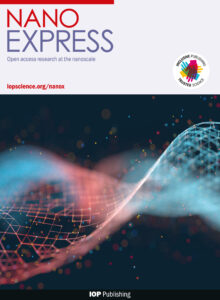NANOX特刊征稿|Focus on Photodetection Using Nanostructured Materials

特刊详情
客座编辑
- Sudhir Husale,印度科学与工业研究理事会
- Vidya Nand Singh,印度科学与工业研究理事会
- Xu Wang,澳大利亚皇家墨尔本理工大学
主题范围
- Nanostructured thin films.
- Solution-processed quantum dots or nanomaterials.
- Superconducting nanostructures, including meanders or nanowires.
- Photodetection techniques involving 2D nanosheets, nanocrystals, and nanowires.
- Heterostructures composed of nanolayers.
- Hybrid nanomaterials and nanostructures.
- Lithographically nanostructured thin films and Superconducting materials
- 2D Nanolayers and Heterostructures
We aim to provide comprehensive insights into the cutting-edge advancements within these domains and their implications for the future of light detection technology.
投稿流程
特刊文章与NANOX期刊常规文章遵循相同的审稿流程和内容标准,并采用同样的投稿模式。
有关准备文章及投稿的详细信息,可以参阅IOPscience页面的作者指南。
作者可登入期刊主页进行在线投稿,先选择“文章类型”,然后在“选择特刊”的下拉框中选择“Focus on Photodetection Using Nanostructured Materials”。
投稿截止日期:2024年6月30日。
期刊介绍

- 2022年影响因子: 3.0 Citescore: 4.1
- Nano Express(NANOX)是一本新发表的多学科开放获取期刊,致力于纳米科技所有领域新的实验、理论和应用研究的快速出版。NANOX采用快速同行评审流程,对文章的长度要求也非常灵活。涵盖领域包括:纳米结构材料的合成和功能化;化学物质自组装和定向组装成纳米级物体的研究;纳米系统、薄膜和二维材料的物理及化学特性表征;纳米科学的理论与计算;纳米医学、生物技术和制药应用;纳米级能源和利用纳米结构开发替代能源的解决方案;量子现象和技术;材料的纳米制造和图案化;传感和探测器。
